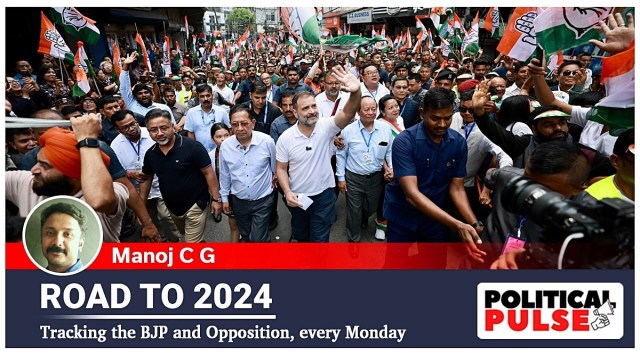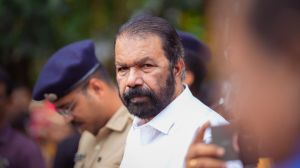Gold, school stipends: Cong refines its welfarism pitch from Nyay to now
Though some Congress leaders are not convinced about the ambitious promises the party's state units are making, others believe that social justice and welfarism are required to counter BJP’s Hindutva plank and a few regional parties’ freebie blitz.
 The Congress’s state units are promising sops and cash doles in each Assembly election. (X/@INCIndia)
The Congress’s state units are promising sops and cash doles in each Assembly election. (X/@INCIndia) Rahul Gandhi sprang a surprise in January 2019, announcing months before the Lok Sabha elections that his party would guarantee every poor person in India a minimum income if it came to power. Two months later, Rahul, then the Congress president, came up with Nyay, the party’s main promise for the elections. Under the Nyuntam Aay Yojana, Nyay in short, the poorest 20% of all families were promised an annual cash transfer of Rs. 72,000.
Though the Congress felt at the time that Nyay was going to be a game-changer, it failed to enthuse voters. But the fact remains that it conceptualised inputs from economists of repute such as former Reserve Bank of India (RBI) Governor Raghuram Rajan and Nobel laureate Abhijit Banerjee. Former Prime Minister Manmohan Singh was consulted before it was given a final shape by in-house economists such as P Chidambaram and Praveen Chakravarty.
Five years down the line, the Congress’s state units are promising sops and cash doles in each Assembly election, the latest being the promise of stipends for schoolchildren in Madhya Pradesh. The Telangana unit is reportedly set to promise 10 gms of gold to eligible women at the time of marriage besides Rs 1 lakh cash, and free internet to students. The party is encouraged by the electoral response its promises received in Himachal Pradesh and Karnataka.
Congress leaders in Delhi say there has not been much discussion on various aspects of these promises in a structured manner as was done in the case of Nyay. They say state units are coming up with promises depending on the local situation and are getting central leaders, the likes of Sonia Gandhi, Rahul Gandhi and Priyanka Gandhi Vadra, to announce them. On their previous visits to Madhya Pradesh, Rahul and Priyanka read out the promises — the latter with some amount of prompting. While Rahul promised that a Congress-led government would give Rs 1,500 per month to every woman, give gas cylinders for Rs 500, provide 100 units of free electricity, and increase the rate of tendu patta to Rs 4,000 per sack, Priyanka announced that under the Padho aur Padhao Yojana children in classes 1 to 8 would receive Rs 500 every month, those in classes 9 and 10 will receive Rs 1,000 per month, and students in classes 11 and 12 will receive Rs 1,500 each month.
Last month, Sonia Gandhi announced a similar set of promises for Telangana — among them, financial assistance of Rs 2,500 per month to women, LPG cylinders for Rs 500, free bus travel for women across the state, Rs 5 lakh grant to the homeless under Indiramma Housing scheme, 250 square yards of residential plots for all those who participated in the Telangana movement, Rs 15,000 per acre to every farmer each season, Rs 12,000 each to every tenant farmer and farm labourer, and Rs 10 lakh medical insurance to all.
The Karnataka model
The party followed similar tactics in Karnataka. And now it has become some sort of a template. The party felt announcements made in manifestos closer to the voting day never really percolated down to voters at the ground level.
In Karnataka, it rolled out the promises in a staggered manner. Priyanka announced the Gruha Lakshmi scheme promising Rs 2,000 per month to women-led households months before elections; Siddaramaiah and D K Shivakumar unveiled the second promise of 200 units of free electricity a few days later; two months before the elections, Rahul unveiled the promise of 3,000 every month to unemployed youth with graduation degree and followed it up with free bus ride scheme for women in the middle of the campaign.
While a section of the party’s central leaders are not convinced about the ambitious electoral promises being made by the state units — as they believe it will drain the exchequer — the overwhelming view in the party is that it has to strike a clear “left of the centre’” path, leaning on both social justice and welfarism to counter the BJP’s Hindutva push and the freebie blitz of some of the regional parties. It is apparent that the party’s manifesto for the Lok Sabha elections will be packed with such promises.
EC’s intervention, Congress’s response
Interestingly, around the same time last year, the Election Commission (EC) wrote to political parties asking them to spell out ways and means of raising additional resources to finance their poll promises and the impact it will have on the fiscal sustainability of the state or the Central government. Floating a consultation paper, the EC, in a letter to all recognised national and state parties, prescribed a standardised disclosure proforma for them to declare the quantification of the physical coverage of the schemes promised, financial implications of the promises, and availability of financial resources.
The Congress opposed it tooth and nail. In its reply to the EC, the Congress said freebies were “part of the dialectics of a vibrant democratic system” and they were “relatable to the give and take thrust of politics (and) they depend on the wisdom, the discernment and analysis of the electorate which should never be taken to be less than acute”.
The Congress went on to say, “It is really something which is to be decided, be it pre-election or post-election, be it by way of electoral punishment or electoral acceptance and reward that the electorate decides the wisdom of such poll promises or campaign assurances and equally decides their breach and non-compliance. Neither the Election Commission, nor the Government, nor indeed even the Courts, have jurisdiction to justiciate and regulate such issues. It would therefore be best for the Commission to desist from doing so.”
With Madhya Pradesh Chief Minister Shivraj Singh Chouhan betting big on his Ladli Behana Yojana — he has already hiked the monthly payout to Rs 1,250 for women from poor families in the 21-60 age group and promised to take it to Rs 3,000 in the future — the Congress believes Prime Minister Narendra Modi’s attack on Opposition states calling such sops “revdi culture” has little meaning and the party need not shy away from announcing cash doles or come under pressure.



- 01
- 02
- 03
- 04
- 05




























